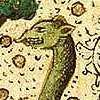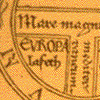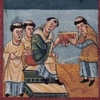 |
Reading #1. In this passage,
Hrabanus inventories the "mystical" meanings of the word terra. He
demonstrates both interpretations "in bonum," when something is
understood in terms of Christ and salvation, and interpretations of the
same object "in malum," when it is understood in terms of the
devil and sin. |
 |
Reading #2. Here Hrabanus moves
on to a tradition of geography in more familiar terms; in particular, he
is very worried about the ways in which the world is "round" and the ways
in which it is "square" defined by 4 cardinal points. How can the world
be both round and square at the same time? Euclid to the rescue! |
 |
Reading #3. In this final passage
of geography, Hrabanus discusses the division of the lands between Europe,
Africa and Asia, together with an allegorical interpretation of this arrangement
of the world: the world is divided into three parts like the three measures
of flour in the parable of the woman and the yeast. |



